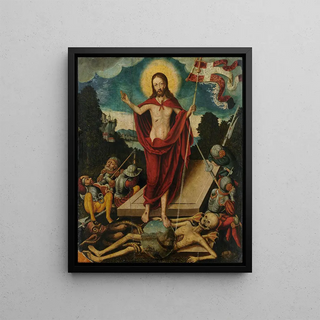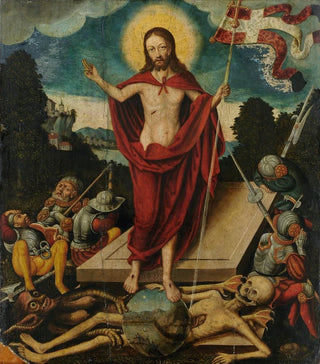Art print | The Resurrection of Christ and the Triumph over Death and the Devil - Lucas Cranach the Elder


View from behind

Frame (optional)
Art print La Resurrection of Christ and the Triumph over Death and the Devil - Lucas Cranach the Elder – Captivating Introduction
In the vibrant universe of Renaissance painting, the work of Lucas Cranach the Elder stands out for its spiritual depth and innovative approach to religious themes. "The Resurrection of Christ and the Triumph over Death and the Devil" embodies this duality between light and shadow, between life and death. This masterful representation of the resurrection, where Christ triumphs over evil forces, invites the viewer to reflect on the very nature of faith and hope. Immersing oneself in this piece, one cannot help but be struck by the intensity of the emotions it conveys, as well as by the richness of the details that testify to the genius of its creator.
Style and uniqueness of the work
Cranach's work is characterized by a palette of vibrant colors and a carefully orchestrated composition. In "The Resurrection of Christ and the Triumph over Death and the Devil," the dynamism of the characters and the fluidity of the draperies recall Italian influences while maintaining an unmistakable German touch. Christ, at the center of the canvas, radiates divine light, contrasting with the dark figures of the devil and death, which curl at his feet. This dichotomy between the sacred and the profane is accentuated by powerful symbols, such as the serpent, representing evil, and angels, bearers of good news. The artist thus manages to create an atmosphere that is both dramatic and comforting, where the victory of good over evil is celebrated with palpable fervor.
The artist and his influence
Lucas Cranach the Elder, an emblematic figure of German Renaissance, marked his era with his distinctive style and artistic innovations. Born in 1472, he skillfully combined influences from Flemish and Italian painting while developing a unique aesthetic that is recognizable. His involvement in the Protestant Reformation also shaped his work, allowing him to explore spiritual themes with unprecedented depth. Cranach was not merely a painter, but also a

Matte finish

View from behind

Frame (optional)
Art print La Resurrection of Christ and the Triumph over Death and the Devil - Lucas Cranach the Elder – Captivating Introduction
In the vibrant universe of Renaissance painting, the work of Lucas Cranach the Elder stands out for its spiritual depth and innovative approach to religious themes. "The Resurrection of Christ and the Triumph over Death and the Devil" embodies this duality between light and shadow, between life and death. This masterful representation of the resurrection, where Christ triumphs over evil forces, invites the viewer to reflect on the very nature of faith and hope. Immersing oneself in this piece, one cannot help but be struck by the intensity of the emotions it conveys, as well as by the richness of the details that testify to the genius of its creator.
Style and uniqueness of the work
Cranach's work is characterized by a palette of vibrant colors and a carefully orchestrated composition. In "The Resurrection of Christ and the Triumph over Death and the Devil," the dynamism of the characters and the fluidity of the draperies recall Italian influences while maintaining an unmistakable German touch. Christ, at the center of the canvas, radiates divine light, contrasting with the dark figures of the devil and death, which curl at his feet. This dichotomy between the sacred and the profane is accentuated by powerful symbols, such as the serpent, representing evil, and angels, bearers of good news. The artist thus manages to create an atmosphere that is both dramatic and comforting, where the victory of good over evil is celebrated with palpable fervor.
The artist and his influence
Lucas Cranach the Elder, an emblematic figure of German Renaissance, marked his era with his distinctive style and artistic innovations. Born in 1472, he skillfully combined influences from Flemish and Italian painting while developing a unique aesthetic that is recognizable. His involvement in the Protestant Reformation also shaped his work, allowing him to explore spiritual themes with unprecedented depth. Cranach was not merely a painter, but also a






